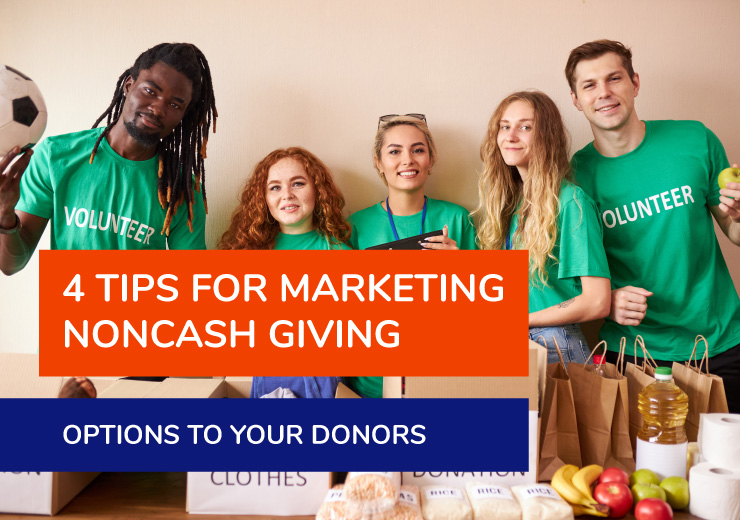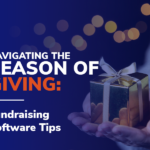4 Tips for Marketing Noncash Giving Options to Your Donors

When you hear about noncash donations, you may think of in-kind gifts or volunteering. After all, many supporters may choose to donate their time instead of money for a variety of reasons. But the world of noncash giving goes beyond that.
In recent years, a new type of online fundraising has emerged: donations of high-value noncash assets like stock and cryptocurrency.
These types of donations allow donors to give in greater amounts while earning more tax benefits, but many supporters don’t even know they have the option to donate them. If your nonprofit accepts gifts of noncash assets, marketing that option to donors is vital. You may find that there are lots of potential donors who would give in this less common way. In this article, we’ll cover four marketing tips your nonprofit can use to improve your strategy:
- Emphasize the greater impact donors can make.
- Provide basic information about the asset donation process.
- Explain and highlight the tax benefits.
- Promote noncash giving options across marketing channels.
Let’s explore how you can develop a promotional campaign specifically for noncash giving options with these strategies.
What kinds of noncash assets can nonprofits accept?
Before you dive into creating your marketing plan using our tips, you need to know the basics of asset donations, beginning with the kinds of noncash assets nonprofits can accept. These include:
- Stocks: Donors can transfer ownership of stock shares to nonprofits. When you accept a stock donation, your nonprofit can choose to liquidate donations into cash or reinvest the funds.
- Cryptocurrency: Gifts of Bitcoin, Ethereum, and other common cryptocurrencies can be converted to cash quickly to avoid market volatility.
- DAF grants: Donor-advised funds (DAFs) are charitable accounts that individual donors set up to fund various nonprofits over time. At any time, they can request to donate a grant from the fund to your nonprofit on their behalf.
- Endowments: Gifted endowments are large sources of funding that are meant to grow over time instead of being used right away. An endowment is similar to a DAF, except that endowments can be gifted directly to your nonprofit, giving your organization more control of the funds. Endowments can either be unrestricted or restricted, and if the donor dictates what they’d like the money to be used for, you’ll need to make sure you’re familiar with UPMIFA (the Uniform Prudent Management of Institutional Funds) which is the legal framework for monitoring restricted endowments.
Each type of donation comes with its own unique stipulations, but all of them offer enticing tax benefits to donors. Whether your nonprofit accepts just one or all of these noncash donation options, you can use these marketing tips to make donors aware of and excited about the possibilities.
1. Emphasize the greater impact donors can make.
One of the biggest incentives of noncash donations is the long-lasting impact donors can make with them, especially through endowments and donor-advised funds. According to Infinite Giving’s nonprofit endowment guide, donors love endowments because they allow them to create a sustainable legacy throughout and beyond their lifetimes.
To get donors interested in your asset donation options, emphasize this power to make a greater impact in your marketing materials. You can do this in a number of creative ways, such as:
- Sharing real beneficiary stories of the impact other donors have made with their noncash contributions on your website, in your newsletter, or on social media.
- Publicly recognizing donors who gift endowments or other major noncash gifts to thank them for their commitment to long-lasting support.
- Adding a section on the impact of noncash gifts in your annual report.
As you promote these options, don’t forget to let donors know that they’ll have complete transparency into the growth of their gift and the impact it makes over time. Personally update donors who give endowments, DAF grants, and other large noncash donations on a regular basis to keep them informed and engaged.
2. Provide basic information about the asset donation process.
Since many donors aren’t even aware that they can donate noncash assets, most of your supporters likely don’t know how the donation process works, either. Donors may think that donating stock or setting up an endowment is a complex process, so it’s helpful to break it down into simple steps in your outreach. The more donors understand how noncash donations work, the more likely they are to give.
Create a set of basic informational marketing materials that will help donors understand and feel confident in the process, such as:
- Branded social media infographics that explain steps donors need to take to donate stock, cryptocurrency, or other noncash assets. These graphics can be reused and even sent to individual donors who have questions about the process.
- A dedicated page on your website that breaks down how to donate noncash assets and why donors should consider them. Along with step-by-step instructions for donating each type of noncash gift, this is a great place to highlight the long-lasting impact donors can have with these gifts.
- A collection of helpful resources for donors who want to learn more. If donors are unfamiliar with asset donations or just want more details about the process, link them to outside resources from reputable websites.
If you use a donation platform to accept noncash gifts, emphasize how easy and quick it is to give through your donation page. Be sure to provide the link along with brief instructions whenever you promote these options.
3. Explain and highlight the tax benefits.
Donors give to your nonprofit because they believe in your mission and want to help you make a difference in the world. However, it doesn’t hurt when there’s an extra incentive for donors to give.
Tax benefits are a large part of the appeal of noncash donations, so embrace it when communicating with donors. It’s possible to keep the overall focus on the impact of noncash donations while still providing information on the extra benefits to further engage donors. The two main benefits you’ll want to highlight are:
- Avoiding capital gains taxes: Donating cryptocurrency and stock means that donors don’t have to pay capital gains taxes on the appreciation of these assets, and they get a tax deduction for the charitable contribution on top of that.
- Getting more immediate tax deductions: DAF-holders receive tax deductions when they make contributions to their fund, even if they don’t donate those funds to a nonprofit immediately. This means they can receive a tax deduction sooner, let the fund grow over time, then donate a larger amount to your nonprofit later.
Include information about these benefits in donation appeals and on your website. For donors who want more in-depth information, link to resources like official IRS guidance. This will not only encourage donors to learn more about noncash giving, it also promotes transparency and trust between your organization and your donors.
4. Promote noncash giving options across marketing channels.
Promoting noncash giving options across a variety of communication channels gives you access to a wider audience and keeps noncash giving fresh in donors’ minds. Go beyond email, choosing marketing channels based on any donor preferences you’ve noted in your database and which online platforms your audience tends to be most active on.
Once you’ve chosen your channels, Double the Donation’s digital marketing guide recommends crafting messages based on the unique strengths of each channel. For example, you might create a video featuring testimonials of donors who’ve gifted endowments and post it on Instagram. Or, consider writing a blog series for your website that highlights each type of noncash giving over the course of a month.
As you refine your multichannel strategy, pay attention to website traffic sources and engagement metrics for each platform to see which channels drive the most donors to give. Let these metrics guide your marketing approach in the future.
With these strategies, you’ll develop a robust noncash giving program that excites donors in no time. Once you start soliciting asset donations, don’t forget to prioritize thanking donors and building strong relationships.


